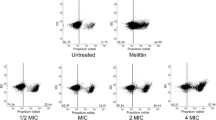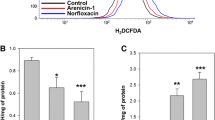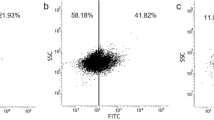Abstract
Modern antibiotics have been developed with the aim of destroying cellular function; however, the risk of antibiotic-resistance is increasing continuously. As a result, antimicrobial peptide (AMP) is considered a novel strategy to substitute traditional drugs. This study focused on revealing the antibacterial mechanism(s) of periplanetasn-4, an AMP identified from Cockroach. To elucidate whether periplanetasin-4 generates reactive oxygen species (ROS), a crucial stress factor for cell death, intracellular ROS was measured in Escherichia coli. The degree of membrane and DNA damage was determined using the properties that ROS causes oxidative stress to cell components. Unlike normal cell death, membrane depolarization was observed but DNA fragmentation did not occur. In addition, accumulation of nitric oxide (NO), a free radical with high toxicity, was measured and the byproduct of NO also induced severe intracellular damage. Periplanetasin-4-induced NO also impacted on cytosol calcium levels and triggered lipid peroxidation and DNA oxidation. These features were weakened when NO synthesis was interrupted, and this data suggested that perplanetasin-4-induced NO participates in E. coli cell damage. Moreover, this AMP-induced NO stimulates expression of SOS repair proteins and activation of RecA, a bacterial caspase-like protein. Features of nitrosative damage did not occur especially without dinF gene which is associated with oxidative stress. Therefore, it was indicated that when there is a NO signal, dinF promotes cell death. In conclusion, the combined investigations demonstrated that the antibacterial mechanism(s) of periplanetasin-4 was a NO-induced cell death, and dinF gene is closely related to cell death pathway.
Graphic Abstract






Similar content being viewed by others
References
Scott MG et al (2002) The human antimicrobial peptide LL-37 is a multifunctional modulator of innate immune responses. J Immunol 169(7):3883–3891
Sperandio B et al (2008) Virulent Shigella flexneri subverts the host innate immune response through manipulation of antimicrobial peptide gene expression. J Exp Med 205(5):1121–1132
Lam SJ et al (2016) Combating multidrug-resistant Gram-negative bacteria with structurally nanoengineered antimicrobial peptide polymers. Nat Microbiol 1(11):1–11
Lázár V et al (2018) Antibiotic-resistant bacteria show widespread collateral sensitivity to antimicrobial peptides. Nat Microbiol 3(6):718–731
Nizet V (2006) Antimicrobial peptide resistance mechanisms of human bacterial pathogens. Curr Issues Mol Biol 8(1):11
Yeaman MR, Yount NY (2003) Mechanisms of antimicrobial peptide action and resistance. Pharmacol Rev 55(1):27–55
Tamba Y, Yamazaki M (2005) Single giant unilamellar vesicle method reveals effect of antimicrobial peptide magainin 2 on membrane permeability. Biochemistry 44(48):15823–15833
Mangoni ML et al (2004) Effects of the antimicrobial peptide temporin L on cell morphology, membrane permeability and viability of Escherichia coli. Biochemical Journal 380(3):859–865
Uyterhoeven ET et al (2008) Investigating the nucleic acid interactions and antimicrobial mechanism of buforin II. FEBS Lett 582(12):1715–1718
Lee H, Hwang JS, Lee DG (2019) Periplanetasin-4, a novel antimicrobial peptide from the cockroach, inhibits communications between mitochondria and vacuoles. Biochem J 476(8):1267–1284
Luiking YC, Engelen MP, Deutz NE (2010) Regulation of nitric oxide production in health and disease. Curr Opin Clin Nutr Metab Care 13(1):97
Crane BR, Sudhamsu J, Patel BA (2010) Bacterial nitric oxide synthases. Annu Rev Biochem 79:445–470
Sudhamsu J, Crane BR (2009) Bacterial nitric oxide synthases: what are they good for? Trends Microbiol 17(5):212–218
Jones ML et al (2010) Antimicrobial properties of nitric oxide and its application in antimicrobial formulations and medical devices. Appl Microbiol Biotechnol 88(2):401–407
Kim H, Lee DG (2020) Nitric oxide–inducing Genistein elicits apoptosis-like death via an intense SOS response in Escherichia coli. Appl Microbiol Biotechnol 104(24):10711–10724
Kim H, Lee DG (2021) Lupeol-induced nitric oxide elicits apoptosis-like death within Escherichia coli in a DNA fragmentation-independent manner. Biochemical Journal 478(4):855–869
Kim I-W et al (2016) De novo transcriptome analysis and detection of antimicrobial peptides of the American cockroach Periplaneta americana (Linnaeus). PLoS One 11(5):e0155304
Almeida B et al (2007) NO-mediated apoptosis in yeast. J Cell Sci 120(18):3279–3288
Nishimura A, Kawahara N, Takagi H (2013) The flavoprotein Tah18-dependent NO synthesis confers high-temperature stress tolerance on yeast cells. Biochem Biophys Res Commun 430(1):137–143
Baba T et al (2006) Construction of Escherichia coli K-12 in-frame, single-gene knockout mutants: the Keio collection. Molecular systems biology. https://doi.org/10.1038/msb4100050
Lee B, Lee DG (2017) Reactive oxygen species depletion by silibinin stimulates apoptosis-like death in escherichia coli. J Microbiol Biotechnol 27(12):2129–2140
Lee H, Lee DG (2019) SOS genes contribute to Bac8c induced apoptosis-like death in Escherichia coli. Biochimie 157:195–203
Allen SA et al (2010) Furfural induces reactive oxygen species accumulation and cellular damage in Saccharomyces cerevisiae. Biotechnol Biofuels 3(1):1–10
Kamat J et al (2000) Reactive oxygen species mediated membrane damage induced by fullerene derivatives and its possible biological implications. Toxicology 155(1–3):55–61
Roos WP, Thomas AD, Kaina B (2016) DNA damage and the balance between survival and death in cancer biology. Nat Rev Cancer 16(1):20
Vumma R et al (2016) Antibacterial effects of nitric oxide on uropathogenic Escherichia coli during bladder epithelial cell colonization—a comparison with nitrofurantoin. J Antibiot 69(3):183–186
Pereira L et al (2017) β-Adrenergic induced SR Ca2+ leak is mediated by an Epac-NOS pathway. J Mol Cell Cardiol 108:8–16
Xiong Z-Q et al (2013) The mechanism of antifungal action of a new polyene macrolide antibiotic antifungalmycin 702 from Streptomyces padanus JAU4234 on the rice sheath blight pathogen Rhizoctonia solani. PloS One 8(8):e73884
Michel B (2005) After 30 years of study, the bacterial SOS response still surprises us. PLoS Biol 3(7):e255
Rodríguez-Beltrán J et al (2012) The Escherichia coli SOS gene dinF protects against oxidative stress and bile salts. PloS one 7(4):e34791
Peeters SH, de Jonge MI (2018) For the greater good: Programmed cell death in bacterial communities. Microbiol Res 207:161–169
Moges F et al (2016) Cockroaches as a source of high bacterial pathogens with multidrug resistant strains in Gondar town, Ethiopia. BioMed Res Int. https://doi.org/10.1155/2016/2825056
Ali SM et al (2017) Identification and characterization of antibacterial compound (s) of cockroaches (Periplaneta americana). Appl Microbiol Biotechnol 101(1):253–286
Hong J et al (2017) The American cockroach peptide periplanetasin-2 blocks Clostridium Difficile toxin A-induced cell damage and inflammation in the gut. J Microbiol Biotechnol 27(4):694–700
Yoon IN et al (2017) The American cockroach peptide periplanetasin-4 inhibits Clostridium difficile toxin A-induced cell toxicities and inflammatory responses in the mouse gut. J Pept Sci 23(11):833–839
Yun J, Hwang J-S, Lee DG (2017) The antifungal activity of the peptide, periplanetasin-2, derived from American cockroach Periplaneta americana. Biochemical Journal 474(17):3027–3043
Kohanski MA et al (2008) Mistranslation of membrane proteins and two-component system activation trigger antibiotic-mediated cell death. Cell 135(4):679–690
Uhl L, Dukan S (2016) Hydrogen peroxide induced cell death: the major defences relative roles and consequences in E. coli. PloS one 11(8):e0159706
Smirnova GV et al (2015) Extracellular superoxide provokes glutathione efflux from Escherichia coli cells. Res Microbiol 166(8):609–617
Islam BU et al (2015) Pathophysiological role of peroxynitrite induced DNA damage in human diseases: a special focus on poly (ADP-ribose) polymerase (PARP). Indian J Clin Biochem 30(4):368
Bicker G (2001) Sources and targets of nitric oxide signalling in insect nervous systems. Cell Tissue Res 303(2):137–146
Bryan NS, Bian K, Murad F (2009) Discovery of the nitric oxide signaling pathway and targets for drug development. Front Biosci 14(1):1–18
Privett BJ et al (2012) Examination of bacterial resistance to exogenous nitric oxide. Nitric Oxide 26(3):169–173
Sun C et al (2018) Nitric oxide acts downstream of hydrogen peroxide in regulating aluminum-induced antioxidant defense that enhances aluminum resistance in wheat seedlings. Environ Exp Bot 145:95–103
Forstermann U, Sessa WC (2012) Nitric oxide synthases: regulation and function. Eur Heart J 33(7):829–37
Maslowska KH, Makiela-Dzbenska K, Fijalkowska IJ (2019) The SOS system: a complex and tightly regulated response to DNA damage. Environ Mol Mutagen 60(4):368–384
Asplund-Samuelsson J (2015) The art of destruction: revealing the proteolytic capacity of bacterial caspase homologs. Mol Microbiol 98(1):1–6
Brambilla E et al (2018) DnaA and LexA proteins regulate transcription of the uvrB gene in Escherichia coli: the role of DnaA in the control of the SOS regulon. Front Microbiol 9:1212
Janion C (2008) Inducible SOS response system of DNA repair and mutagenesis in Escherichia coli. Int J Biol Sci 4(6):338
Acknowledgements
This work was supported by a grant from the Next-Generation BioGreen 21 Program (Project No. PJ01325603), Rural Development Administration, Republic of Korea. This manuscript also has been grammatically edited by a native speaker, a professional editing firm, Enago.
Funding
This research did not receive any specific grant from funding agencies in the public, commercial, or nonprofit sectors.
Author information
Authors and Affiliations
Contributions
H. Lee, J.S. Hwang, and D.G. Lee conceived the study and designed the experiment. H. Lee performed the experiments and collected the data. H. Lee and D.G. Lee analyzed the data. H. Lee wrote the manuscript.
Corresponding author
Ethics declarations
Conflict of interest
The authors declare that they have no conflict of interest.
Additional information
Publisher's Note
Springer Nature remains neutral with regard to jurisdictional claims in published maps and institutional affiliations.
Supplementary Information
Below is the link to the electronic supplementary material.
Rights and permissions
About this article
Cite this article
Lee, H., Hwang, J.S. & Lee, D.G. dinF Elicits Nitric Oxide Signaling Induced by Periplanetasin-4 from American Cockroach in Escherichia coli. Curr Microbiol 78, 3550–3561 (2021). https://doi.org/10.1007/s00284-021-02615-5
Received:
Accepted:
Published:
Issue Date:
DOI: https://doi.org/10.1007/s00284-021-02615-5




